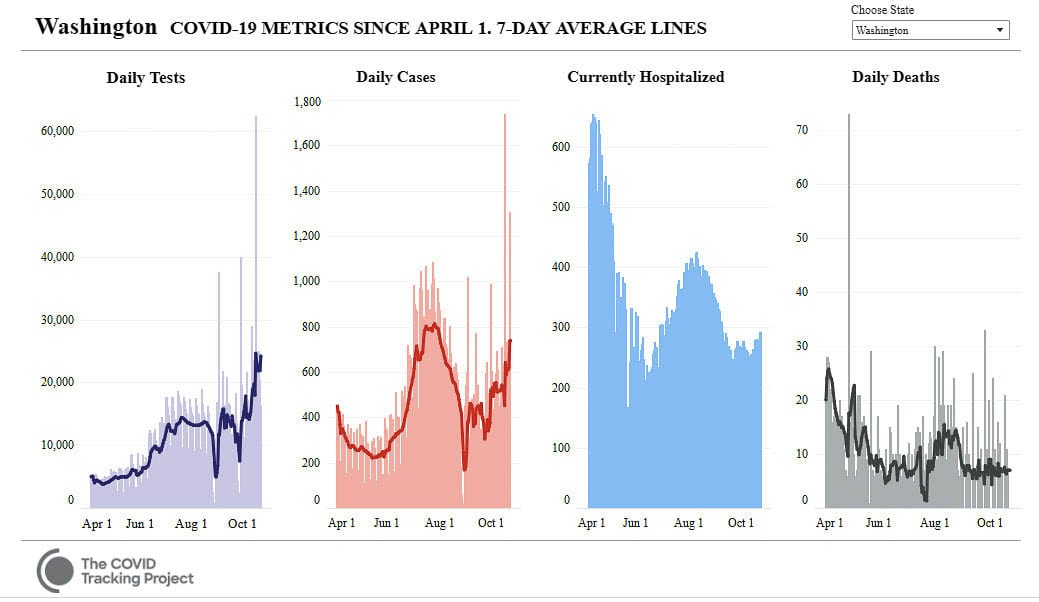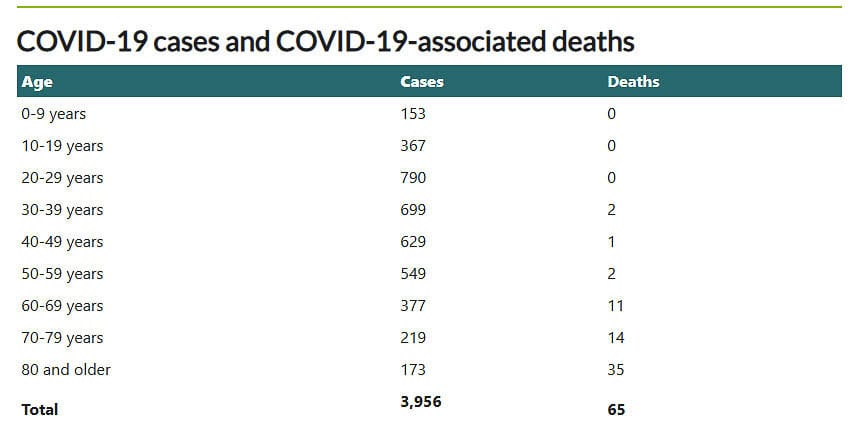Recent research shows chances of dying have fallen nearly 18 percent across age groups
The recent increase in reported COVID-19 cases has pushed Clark County far into the “high” area of the Washington State Department of Health guidelines. The county is at 115 cases per 100,000 people as of this week, and that number appears likely to rise even further.
That rate is important in how it is used to determine whether businesses can reopen and at what capacity, and school districts are stuck in online-only learning modes until it falls below 75 per 100,000 for at least three weeks.
Yet, even as case rates go up, the number of people dying from COVID-19 remains relatively static, at or below half what the country experienced in March and April. At that time, 2,000-plus Americans were dying each day. Since June the number has remained below 1,000 per day, despite several case surges here and around the country.

The last day the U.S. had over 1,000 COVID-19 deaths on a single day was Sept. 30. The 7-day moving average as of Oct. 19 was 711 deaths per day. The highest number of deaths on any one day was 2,752 on May 7, according to one group collecting data.
In Washington state, the data shows similar declines. The 7-day moving average is seven deaths per day from the virus as of Oct. 19. The number of people hospitalized in the state was 292 on Oct 19.
Here in Clark County, there have been zero deaths for anyone age 29 or younger according to the Clark County Public Health Department (CCPH) data. There were 35 deaths among senior citizens aged 80 or older, 14 deaths of people in their 70’s, and 11 deaths of people in their 60’s.
Clark County Public Health provided Clark County Today a graphic showing hospitalizations over time. A separate graphic shows COVID-19 cases by age group over time.

Through Oct. 20, people over the age of 80 accounted for 181 cases, and 36 fatalities, for a nearly 20 percent fatality rate. People 60-69 years old had seen 399 confirmed cases with 11 fatalities, while there were 223 reported cases in individuals 70-79 years old, with 14 deaths in that age group. Of the 66 reported deaths in Clark County, all but five were over 60, and no one younger than 30 has been reported to have died of COVID-19 in Clark County.

Nationwide, 30 percent of all COVID-19 deaths occurred in the 85 and older age group according to the CDC data. Those 55 and older make up 91 percent of all deaths with COVID-19.
(CDC data includes “deaths involving coronavirus disease 2019 (COVID-19), pneumonia, and influenza reported to NCHS by sex and age group. United States. Week ending 2/1/2020 to 10/10/2020.”)
In recent months, the mortality rate connected with COVID-19 has continued to steadily decline, even in older age groups.
A recent study by the New York University’s Grossman School of Medicine, which looked at thousands of COVID-19 cases between March and August, found that mortality rates in one health system had fallen by 18 percentage points, from a 25.6 percent chance of dying at the start of the pandemic; to 7.6 percent currently.
Another study of some 21,000 cases conducted by the Alan Turing Institute in the United Kingdom found similar mortality rate declines.
Doctors warn that a 7.6 percent chance of dying is still higher than the flu or many other viral diseases.
The improved survivability rate of COVID-19 may be due to a number of factors.
The Wall Street Journal reported last month: “doctors say they have developed a better understanding of who needs a ventilator and how quickly a patient can be discharged, and studies have pointed to a few drugs like the antiviral Remdesivir and the steroid dexamethasone that can help.”
“The Spring ‘was ultimately baptism by fire,’” said Donald Landry, physician in chief of NewYork-Presbyterian/Columbia University Irving Medical Center, to the Wall Street Journal. Now “we understand the illness; we have a variety of treatments.”
Other research has raised the possibility that wearing a mask may reduce exposure to the virus. While you may still end up getting an infection, the reduced viral intake seems, in these studies, to lead to a less severe case of COVID-19 in many people.
“Obviously this can get out of control — we don’t have a magic bullet for it yet,” Dr. Landry added, “but your prospects are actually very good.”
Health experts caution the recent data is not a reason to let your guard down.
Until scientists have a fuller understanding of why mortality rates earlier in the year were so high, they warn, it’s possible that we could return to that state if hospitals become crowded, or people return to life as it was before the pandemic.
“It still has the potential to be very harmful in terms of long-term consequences for many people,” said Dr. Leora Horwitz of NYU and a co-author on the Grossman School of Medicine study recently told NPR News. “I do think this is good news, but it does not make the coronavirus a benign illness.”




